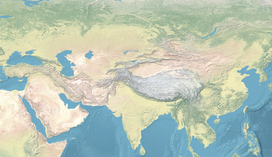
Tian Shan
System of mountain ranges in Central Asia / From Wikipedia, the free encyclopedia
Dear Wikiwand AI, let's keep it short by simply answering these key questions:
Can you list the top facts and stats about Tianshan?
Summarize this article for a 10 year old
The Tian Shan (Chinese: 天山),[note 1] also known as the Tengri Tagh[1] or Tengir-Too,[2] meaning the "Mountains of God/Heaven", is a large system of mountain ranges in Central Asia. The highest peak is Jengish Chokusu at 7,439 metres (24,406 ft) high. Its lowest point is the Turpan Depression, which is 154 m (505 ft) below sea level.[3]
This article may require copy editing for grammar, style, cohesion, tone, or spelling. (July 2023) |
| Tian Shan 天山 | |
|---|---|
| Tengri Tagh, Tengir-Too | |
 The Tian Shan range on the border between China, Kazakhstan and Kyrgyzstan with Khan Tengri (7,010 m) visible at center | |
| Highest point | |
| Peak | Jengish Chokusu |
| Elevation | 7,439 m (24,406 ft) |
| Coordinates | 42°02′06″N 80°07′32″E |
| Geography | |
| Countries | China, Kazakhstan, Kyrgyzstan, Uzbekistan and Tajikistan |
| Range coordinates | 42°N 80°E |
| Geology | |
| Age of rock | Mesozoic and Cenozoic |
| Official name | Xinjiang Tianshan |
| Type | Natural |
| Criteria | vii, ix |
| Designated | 2013 (37th session) |
| Reference no. | 1414 |
| Region | Asia |
| Official name | Western Tien-Shan |
| Type | Natural |
| Criteria | x |
| Designated | 2016 (40th session) |
| Reference no. | 1490 |
| Region | Asia |
One of the earliest historical references to these mountains may be related to the Xiongnu word Qilian (traditional Chinese: 祁連; simplified Chinese: 祁连; pinyin: Qílián), which, according to Tang commentator Yan Shigu, is the Xiongnu word for "sky" or "heaven".[4] Sima Qian, in the Records of the Grand Historian, mentioned Qilian in relation to the homeland of the Yuezhi, and the term is believed to refer to the Tian Shan rather than the range 1,500 kilometres (930 mi) further east now known as the Qilian Mountains.[5][6] The name of the Tannu-Ola mountains in Tuva has the same meaning. The Chinese name Tian Shan is most likely a direct translation of the traditional Kyrgyz name for the mountains, Teñir Too.[1]
The Tian Shan is sacred in Tengrism. Its second-highest peak is known as Khan Tengri, which may be translated as "Lord of the Spirits".[7] At the 2013 Conference on World Heritage, the eastern portion of Tian Shan in western China's Xinjiang Region was listed as a World Heritage Site.[8] The western portion in Kazakhstan, Kyrgyzstan, and Uzbekistan was then listed in 2016.[9]

